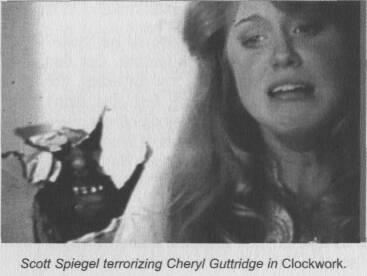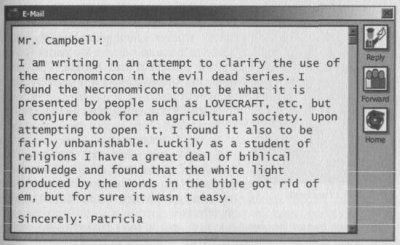If Chins Could Kill: Confessions of a B Movie Actor (14 page)
Read If Chins Could Kill: Confessions of a B Movie Actor Online
Authors: Bruce Campbell
Tags: #Autobiography, #United States, #General, #Biography & Autobiography, #Biography, #Entertainment & Performing Arts - General, #Entertainment & Performing Arts, #Actors, #Performing Arts, #Entertainment & Performing Arts - Actors & Actresses, #1958-, #History & Criticism, #Film & Video, #Bruce, #Motion picture actors and actr, #Film & Video - History & Criticism, #Campbell, #Motion picture actors and actresses - United States, #Film & Video - General, #Motion picture actors and actresses

This experience opened up an entirely new world for Rob, something infinitely more interesting than economics, so he proposed that Sam do a feature film next. Initially, Sam didn't share his enthusiasm.
Sam: I didn't tell Rob what was really going through my mind. We had talked about this for years, but we never could get together to really do it. We had all those conversations in your apartment about how to do it.
Bruce: Yeah, no kidding.
Sam: So, I figured I wouldn't even tell the poor bastard. I won't dampen his spirits. I'll just let him figure out for himself that it's impossible. So I played along, you know what I mean? Okay I'll ride this boat as long as I can take it, but I really didn't think we were going to get the money together for this, but I've never been one to say no.
Preliminary phone calls between the three of us centered on the inevitable question:
Can we make a real film for the real world?
None of us had the answer, but we had nothing to lose either.
I could always move back home,
I reasoned.
For Rob and Sam, it made just as much sense. Rob was in the process of a changing his economics major to fisheries and wildlife, so his future wasn't exactly written in stone. Sam was doing the college thing to avoid what seemed inevitable.
"I wanted to be a filmmaker," Sam admitted, "but I thought that it wasn't going to be possible. I just thought I would run from reality as long as possible until they dragged me back to my dad's store." The other "boys" were wrapped up in other interests and obligations at this time, so it wound up being the three of us against the world.
With the "can we?" question answered rather swiftly and painlessly, we had to focus on the next ones:
Where, what kind
and
how?
Starting with
where,
we couldn't answer that one without asking a few questions of our own. Should we move out to Hollywood? Do we
need
to? In retrospect, that issue never really needed much discussion -- you were simply a traitor if you ever abandoned Michigan.
In reality, I think the prospects of moving across the country were just too daunting. Josh Becker was out in Hollywood already and was feeding us monthly tales of woe. Hell, the poor bastard came down with a case of -- and I'm not kidding -- scurvy, because he survived on a diet of macaroni and cheese while trying to get a film made.
11
THE MIDWEST IS THE THING
So, we decided to root ourselves in the Great Lakes State. We would conquer Hollywood by having nothing to do with it.
The next lingering question was,
What type of film should we make?
That was harder to confront than the decision to do a feature. Our film library at that point consisted almost exclusively of sappy comedies. For some reason, the idea of doing a feature-length yuck fest just didn't compute. The comedies of 1979,
Manhattan
and
1941,
among others, were headlined by well-known comedians or directed by the likes of Woody Allen and Steven Spielberg. Our goofy films, with titles like
Booby Bartenders, Shemp Eats the Moon
and
The Great Bogus Monkey Pignut Swindle,
didn't seem to measure up.
But something that happened during the screenings of the murder mystery flop,
It's Murder!,
made us take note. A suspense scene called for what we later would term a "scare." This played out when a heinous criminal leapt upon an unsuspecting victim from the backseat of a car. Screenings of the film were always met with a lackluster response, but that scene always delivered -- people never failed to jump out of their seats.
"It worked great," Sam noted. "When we showed it, that was the one part, the
only
part of
It's Murder!
that really worked well."
Aside from comedy, "scares" were the only other guarantee of provoking a strong reaction from the audience.
This prompted Sam to write a short film called
Clockwork
-- a creepy little tale about a woman in a home alone who is tormented, for no good reason, by a demented man. It was nothing new, but the end result was very effective and represented a new direction that our films could take -- a turn toward horror.
We decided to do some low-budget, grass roots research into the genre, and one destination seemed requisite -- the
drive-in
theater. Even in 1979, this mode of exhibition was a fading cultural phenomenon. The first-run family films were no longer being shown. Most drive-ins showed either kung fu flicks or horror.
Wading through countless "two films for two dollars," we got the chance to document the behavior of what would become our target audience. If the pace of, say,
Massacre at Central High
dragged, the horns of cars all around us would honk in unified disapproval. If
Revenge of the Cheerleaders
had cheesy effects (which it did), headlights came on and the screen would be washed out for several punishing minutes. The message was loud and clear -- keep the pace fast and furious, and once the horror starts, never let up. "The
gore
the merrier" became our prime directive.
The other thing that stood out among all of these lame-ass films was the fact that very few, if any, boasted the requisite "name" actors, fancy clothes or exotic locations associated with other genres. Aside from ample amounts of blood, they didn't even require that many special effects. For three guys who never managed to come up with more than $2,000 for a film, this was really encouraging news.
With three questions down, all really theoretical, the last one was a quandary:
How would we make it?
What proof did we have to show that we could pull it off?
Clockwork,
for all of its effectiveness, was really just a test.
That's when the idea of filming a "prototype" sprung to mind. By doing so, we could prove not only to ourselves, but to our potential investors, that it was possible.
We decided to make
Within the Woods.
At MSU that year, Sam had been studying H. P. Lovecraft in his literary classes and the
Necronomicon,
or "Book of the Dead," caught his fancy.
Sam: I read a short story in a class, yeah.
Bruce: Called?
Sam: I can't remember what it was called. It was just a writing exercise.
Bruce: Was it about the "Necronomicon"?
Sam: No. It was just about being alone in a cabin -- a scary short story about being alone in a cabin. And at the same time I had a class in ancient history where we studied the "Necronomicon."
Bruce: So it was a combination of creative writing and ancient history.
From these rough concepts, he concocted a short story where a group of kids unwittingly dig up an ancient Indian burial ground and unleash some nasty spirits.
12
THE "PROTOTYPE"
By this point, staging a Super-8 film was old hat. We mustered a cast of regular characters in the spring of 1979 and headed to the Tapert family farmhouse outside of Marshall, Michigan.
One of the many constants in horror films of that day was that the lead
had
to be a woman and she
had
to be terrorized. Ellen Sandweiss was the natural choice as the starlet/female victim. Ellen had been in numerous Super-8s and expressed a sincere desire to be an actress. I was cast as her innocuous boyfriend who would later become possessed and stalk the others relentlessly.
Scott Spiegel, who demonstrated a gory flair in
Clockwork
as the psycho, was cast as the obnoxious boyfriend of Mary Valenti -- daughter of a friend of the Tapert family who also had stars in her eyes.
The film, pieced together over a very hot three-day weekend, would serve as the first hint that films weren't always gonna be as easy as chuckin' pies around in our spare time.
To pull this $1,600 film off, we needed special makeup effects. Up until this time all of our makeup needs were met by a trip to the local costume shop, Van Beau's. This outfit, with astonishingly rude attendants, specialized in Halloween costumes, but also stocked your basic moustaches, spirit gum and derma wax. Between that and liquid shoe polish (which we got at the local drugstore) we had everything we ever needed to age, change identity or die.
But this time, we had to go a little further. Sam's story called for knives into necks and abdomens, mutilated body parts and possessed people. To do this, Rob and Sam enlisted the help of artist-turned-makeup man, Tom Sullivan.
Sam: Tom saw the ad for
The Happy Valley Kid
at MSU. He wanted to see who these student filmmakers were, but hesitated because he saw the name Raimi and he thought it was Iranian. This was when the United States was on very bad terms with Iran.
Bruce: Is that really what he thought?
Sam: Yeah.
Bruce: That's horrible.
Sam: I said, "I'm not Iranian, I'm American," so he goes, "I'm a filmmaker, too, and I do art work and makeup." So, Rob and I went over to his apartment to see his effects.
The shoot began innocently enough, but it soon proved to be much slower than the other Super-8 films. There were new factors, like attempting to do realistic dialogue, special effects and a stepped-up visual design from Sam. Where horror films allowed for simplicity with regard to setting, cast, etc., they more than made up for it in their demand for heightened visuals.
The weekend dragged on, sometimes grinding to a halt while we attempted to attach an "I've-been-stabbed-in-the-chest" rig to Scott's indescribably furry chest. Tom had provided the half-knife prop, but it still had to be secured, wiggle free, to the actor. That's when one of the great staples of Super-8 films came in handy -- duct tape. This hard-to-tear, all-purpose tape had been used to secure everything from lights on ceilings to cameras on car fenders -- it most certainly would suffice to keep a blade plastered to Scott's torso.
The scene you really want to replay, though, is two or three of us huddled around Scott, attempting to get the horrid tape off without exfoliating him more than necessary. Scott decided that only he really knew his own threshold for pain, and yanked the sticky substance off. The end results were far too horrifying to put in any film.



